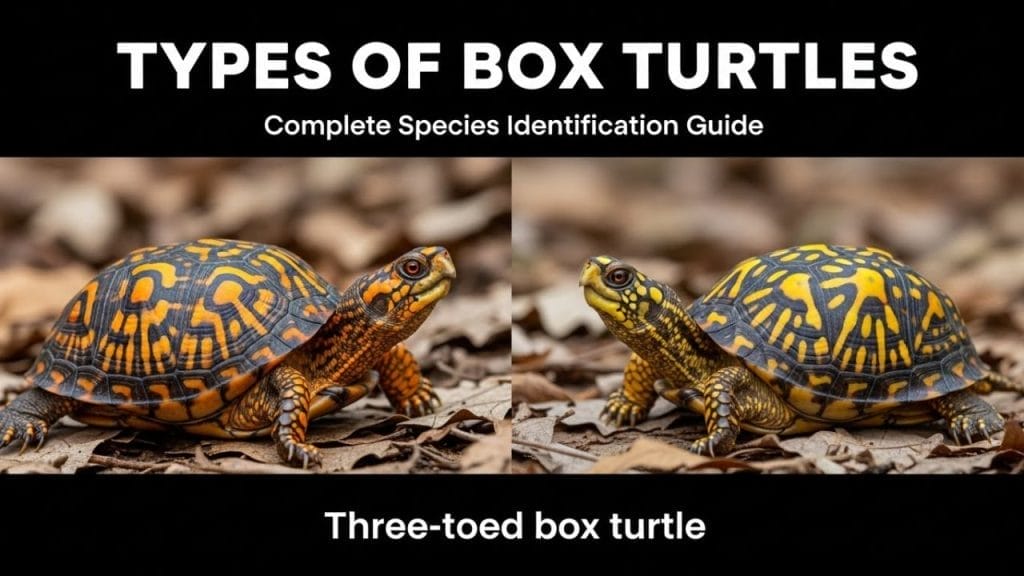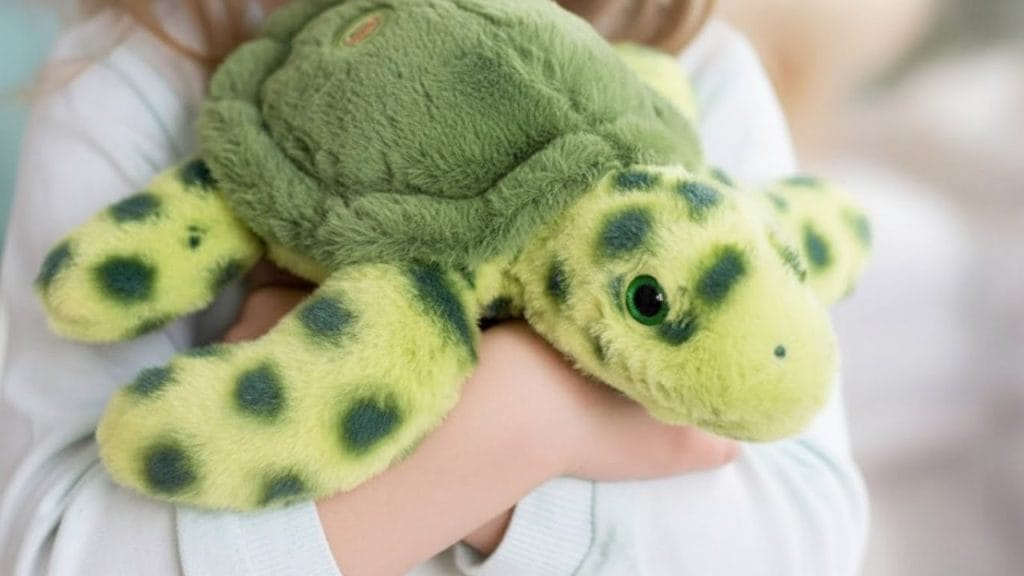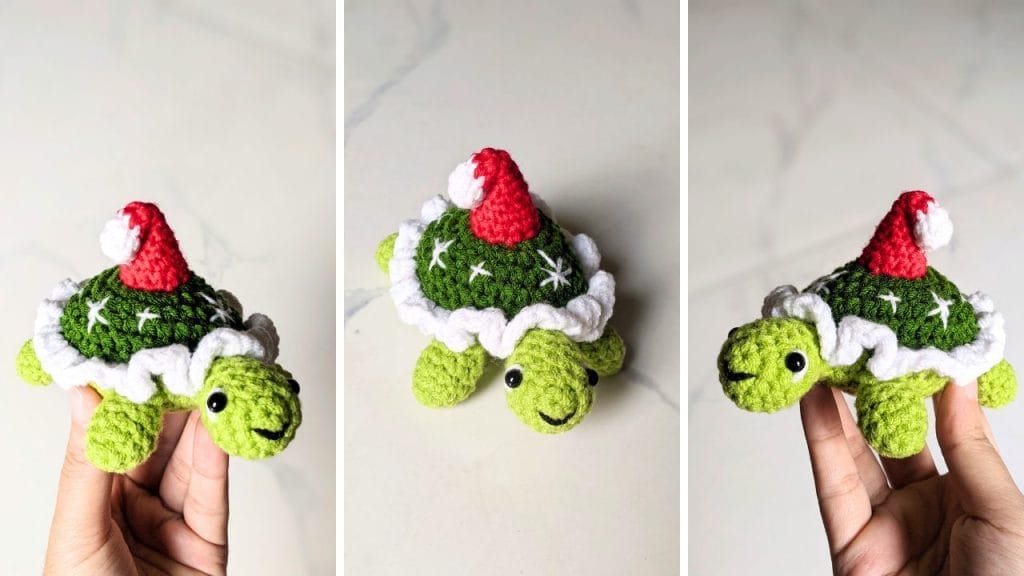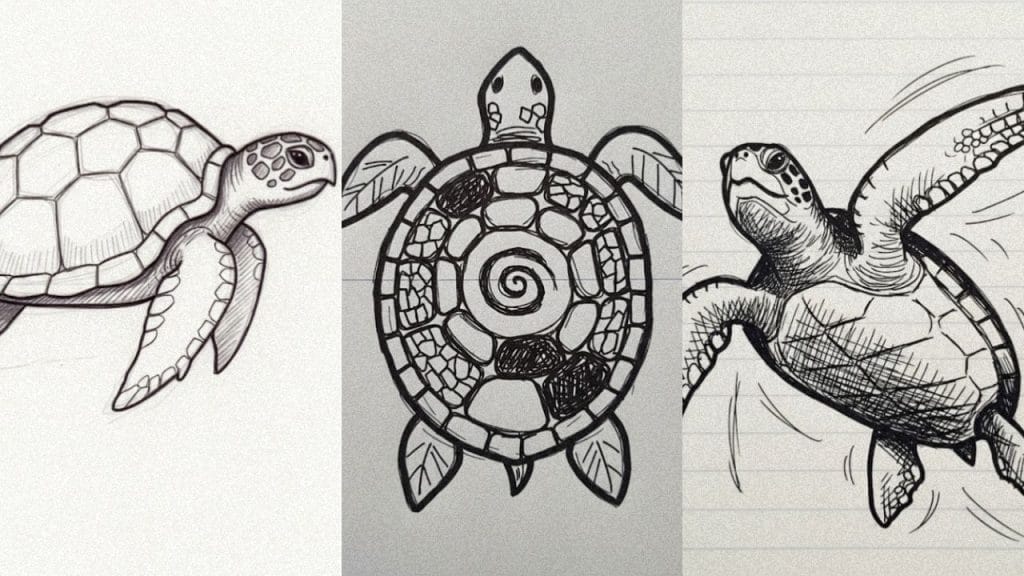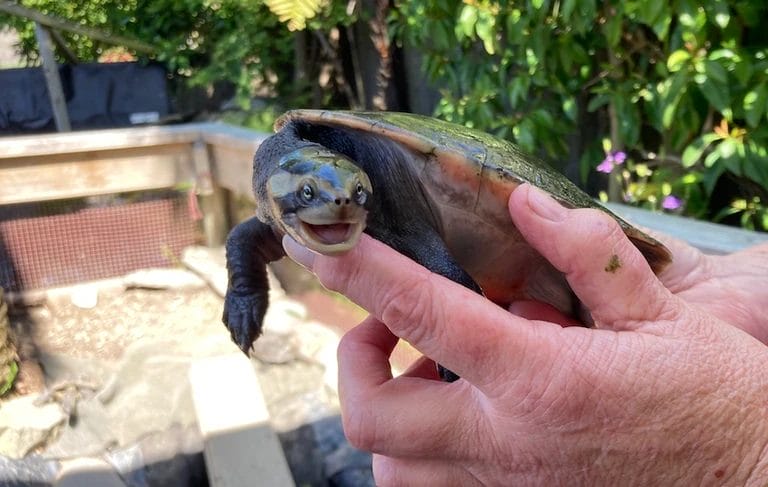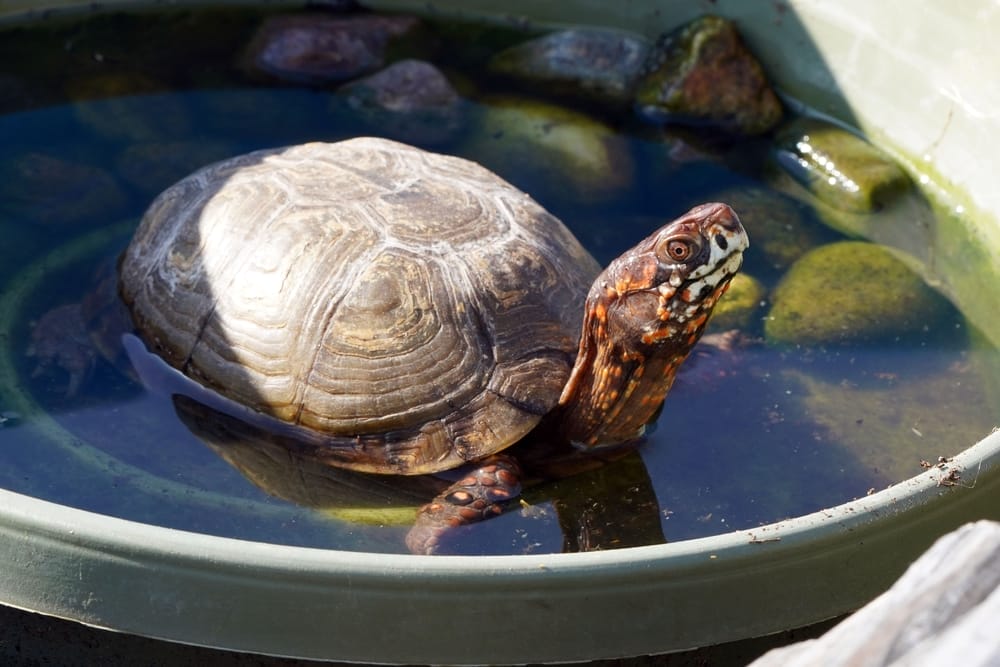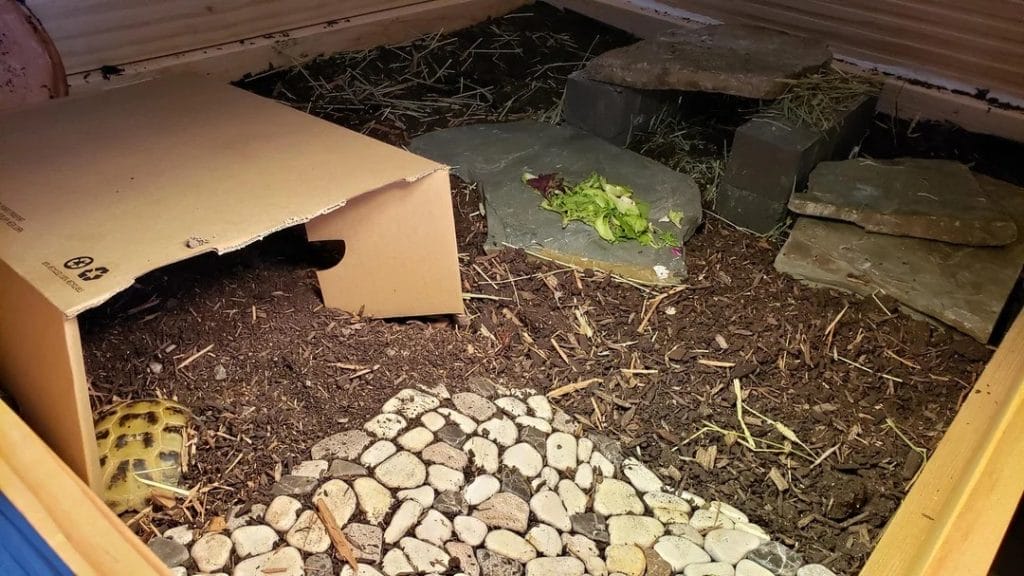The Guide To Feeding A Tortoise [Safe Foods List]

This post was created with help from AI tools and carefully reviewed by a human (Muntaseer Rahman). For more on how we use AI on this site, check out our Editorial Policy.
Are you confused about what to put on your tortoise meal chart and what not to? Well, worry no more. Here is a guide to feeding a tortoise.
Tortoises are vegetarian and prefer weed, grass, hays, flowers, plants, leaves, stems, vegetables and fruits. However, a few species will eat a small amount of animal protein, for example, carrion, insects, worms, etc. An ideal tortoise meal equals food equivalent to the shell size of the creature and follows the 5-days-a-week schedule.
Catch more details inside.
The Guide To Feeding A Tortoise: What To Feed And What To Avoid
Tortoises are herbivorous and can not withstand meat. Well, at least, this is the truth for most tortoise species, while a few can consume both animal and protein matters.
However, if you ask for a general rule, the advice is to feed the tortoises plants, leaves, veggies, and grasses. In addition, you can provide your pets fruits occasionally as treats. Apart from these, mineral and vitamin supplements are necessary for captive turtles.
So, in short, we can divide the tortoise food into the following categories,
- Plants
- Vegetables
- Fruits
- Grasses
- Supplements
- Commercial diet
Plants: What Plants Do Tortoises Eat?
Tortoises eat all types of plants as long as they are non-toxic. Aloe vera, chicory, lettuce, dandelion leaves, Malva, stems, and edible flowers are everyday items to a tortoise meal. Experts suggest greens should make more than 80% of a tortoise diet.
Safe plant options for tortoises are,
- Acanthus
- Aloe vera
- Antirrhinum
- Aubretia
- Basil
- Bindweed
- Bramble
- Bristly oxtongue
- Butter lettuce
- Cactus pads
- Campanula
- Chicory
- Chickweed
- Clover
- Collard greens
- Creeping thistle
- Dandelion leaves
- Edible flowers
- Evening primrose
- Field bindweed
- Hebe
- Hosta
- Hawkbit
- Hawksbread
- Hawkweed
- Ivy-leaved toadflax
- Gazania
- Geraniums
- Green leaf lettuce
- Hibiscus flowers
- Hedge mustard
- Kohl rabi
- Lemon balm
- Mallows
- Malva
- Mulberry leaves
- Mustard leaves
- Nasturtium
- Nettles
- Osteospermum
- Pansy
- Parsley
- Pelargonium
- Petunia
- Plantain plants
- Rapeseed
- Red clover
- Red leaf lettuce
- Rose
- Scotch thistle
- Sea holly
- Shepard’s purse
- Sowthistle
- Sprouts
- Trefoils
- Turnip leaves
- Turtle vine
- Vetches
- Viola
- Watercress, etc.

This Hilarious Turtle Book Might Know Your Pet Better Than You Do
Let’s be real—most turtle care guides feel like reading a textbook written by a sleep-deprived zookeeper.
This one’s not that.
Told from the snarky point of view of a grumpy, judgmental turtle, 21 Turtle Truths You’ll Never Read in a Care Guide is packed with sarcasm, sass, and surprisingly useful insights.
And hey—you don’t have to commit to the whole thing just yet.
Grab 2 free truths from the ebook and get a taste of what your turtle really thinks about your setup, your food choices, and that weird plastic palm tree.
It’s funny, it’s honest, and if you’ve ever owned a turtle who glares at you like you’re the problem—you’ll feel seen.
Vegetables: What Vegetables Can Tortoises Eat?
Tortoises eat a variety of vegetables in both captivity and the wild. Collard green, chard, kale, pumpkin, cabbage, etc., are common vegetable items for the tortoises, and the list goes on. Generally, the tortoise diet should include at least 40% of veggies.
Safe vegetable options for tortoises are,
- Arugula
- Bell pepper
- Broccoli
- Butternut squash
- Carrot
- Cabbage
- Cauliflower
- Celery
- Chard
- Cucumber
- Endive
- Escarole
- Iceberg lettuce
- Kale
- Mushroom
- Pumpkin
- Radish top
- Red cabbage
- Sweet potato
- Yam
- Zucchini, etc.
Fruits: What Fruits Do Tortoises Eat?
Fruits are not mandatory to a tortoise diet. Instead, fruits are an occasional treat to these creatures.
Fruits are high in sugar and do not contain much nutritional value for tortoises. Hence, making the tortoises full on fruits can lead them to malnutrition. Also, it will upset the pets’ tummy.
Tortoises generally love fruity snacks. Here are some fruit options for tortoises,
- Apple
- Apricot
- Banana
- Blueberry
- Blackberry
- Cantaloupe
- Cactus fruit
- Cherry
- Corn
- Figs
- Grapes
- Kiwi
- Mango
- Mulberry
- Oranges
- Papaya
- Peach
- Pear
- Pineapple
- Pomegranate
- Pulm
- Strawberry
- Watermelon, etc.
Grasses: What Grasses Do Tortoises Eat?
Grasses and hays are as crucial in a tortoise’s diet as vegetables and plants. So, you should prioritize these over fruits.
Tortoises eat grass while grazing outside. It takes no effort to grow grass in the backyard and works as an excellent food source for your pets. However, you can also buy fresh grasses from the market and feed the tortoises.
Grassses are high in fiber, protein, minerals, and energy. Thus, you should not exclude this item from your tortoise diet.
There are a variety of grasses and hays available. The favorite ones of tortoises are,
- Alfalfa hay
- Bermuda grass
- Clover grass
- Grass hay
- Meadow hay
- Orchard hay
- Oat hay
- Rice hay
- Rye grass
- Sowthistle
- Timothy hay, etc.
Supplements: Do Tortoises Need Supplements?
Tortoises require calcium and vitamin D supplements for proper growth. However, multivitamins are not mandatory for these reptiles as they live on greens and vegetables.
As you know, tortoises consume very little to no animal matter. Hence, feeding them calcium in the form of supplements is always suggested.
Calcium promotes the shell and bone growth of tortoises. Not only that. This mineral also aids the overall physical development of torotises.
Thus, the lack of calcium will lead to abnormal shell and bone growth among these creatures. Also, they will suffer from many other complexities.
To eliminate such risks, you have to sprinkle calcium on the tortoise meals or adopt any other trick to feed this supplement to your pets. Here is how I provide calcium to my tortoises,
- I leave cuttlefish bones in the enclosure and let the tortoises eat at their pace. Geneally, cuttlebones have a hard shell. You can scrape off the outer layer of this supplement if your tortoises find it annoying.
- Tortoises drink water from time to time. Mixing tortoise blocks in water can be a way to feed calcium to your pets.
- The easiest way to feed calcium to your tortoises is to dust the meals with supplements.
Vitamon D3 is equally necessary for tortoises’ growth. See, these creatures can not absorb calcium without sufficient vitamin D in their system.
Of course, tortoises get vitamin D3 from their diet, but it is not enough. You have to install a UV light in the enclosure to promote vitamin D3 production in their bodies.
In the wild, tortoises absorb UV rays from the sun. Hence, you do not have to set up an artificial lamp if you raise your pets outdoors.
The Calcium-UVB Connection Most Owners Miss
Here’s something critical that feeding guides often skip: calcium supplements are useless without proper UVB lighting.
Your tortoise can eat all the calcium in the world, but without adequate UVB exposure, their body can’t absorb it. The result? Metabolic bone disease, soft shells, and deformities – despite “doing everything right” with diet.
How it works:
- You dust food with calcium powder
- Tortoise eats calcium-rich meal
- UVB light triggers Vitamin D3 production in tortoise’s skin
- Vitamin D3 enables calcium absorption in the gut
- Calcium strengthens bones and shell
Break any link in this chain = calcium deficiency.
This is why the article mentions: “You have to install a UV light in the enclosure to promote vitamin D3 production.” But which UVB light? How close? How long? When to replace it?
For specific UVB requirements:
- Complete UVB Lighting Guide – Bulb types, positioning, replacement schedule
For calcium supplement recommendations:
- Food & Supplements Guide – Which calcium powder, how often, cuttlebone options
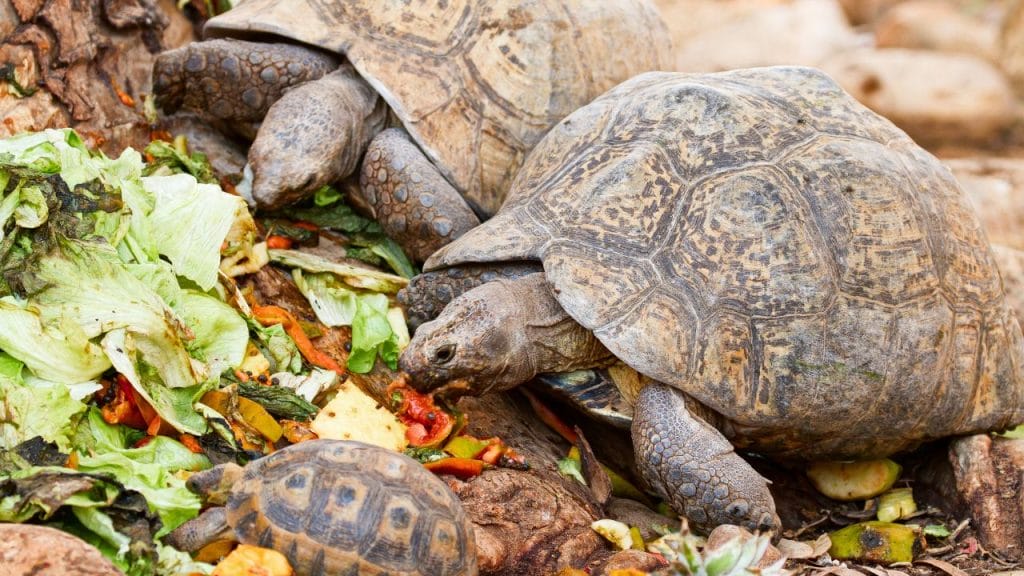
Commercial Diet: Are Store-Bought Items Safe For Tortoises?
It is not advisable to feed commercial foods to your tortoise as they prefer munching natural greens. However, you may have to offer the pets store-bought veggie pallets in a time of crisis.
For example, if your local pet store can not provide fresh leaves, grass, or flowers. Again, many keepers feed their tortoises pellets to eliminate risks of mineral deficiency.
Commercial pellets are definitely nutriton-rich and safe for tortoises. Yet, you should not depend on those packaged foods only. Feeding natural greens is always the best for your pets.
Feeding Setup: How You Serve Food Matters
You know WHAT to feed your tortoise. But WHERE and HOW you serve it affects their health too.
The Substrate Ingestion Problem
When tortoises eat food placed directly on substrate:
- They swallow bits of substrate with each bite
- Over time, this accumulates in their digestive system
- Result: Impaction (blocked intestines) – potentially fatal
The solution: Feed on a surface that prevents substrate ingestion.
Feeding Surface Options:
| Surface | Pros | Cons |
|---|---|---|
| Flat slate tile | Natural look, helps wear beak, easy to clean | Heavy, can get hot under basking light |
| Ceramic dish | Easy to clean, prevents spillage | Needs to be large enough for food variety |
| Terra cotta saucer | Affordable, natural look | Can chip, absorbs moisture |
| Plastic tray | Lightweight, very easy to clean | Not natural looking, can tip |
Feeding Station Best Practices:
- Place away from basking spot – Food wilts and dries under heat lamps
- Use shallow, wide containers – Tortoises need to access food easily
- Heavy enough not to tip – Tortoises bulldoze everything
- Easy to clean daily – Old food grows bacteria
Water Dish Requirements:
The article mentions tortoises need water, but the dish matters:
- Shallow enough for easy entry/exit (especially for small tortoises)
- Heavy enough that they can’t flip it
- Large enough for optional soaking
- Cleaned daily – tortoises defecate in water dishes
For specific dish recommendations: Water & Food Dishes
Food Habit Of Different Tortoise Species
| Tortoise Species | Food Habit |
|---|---|
| Sulcata Tortoise | Sulcata tortoises prefer grass over anything, and so 90% of their diet consists of grass, weed, and hay. Timothy hay, Orchard grass hay, and alfalfa hay top their priority list. Apart from weeds and grasses, you can feed your Sulcata tortoise vegetables and plants. Collard green, kale, mustard green, dandelion greens, turnip, romaine lettuce, beet green, green leafy vegetables, etc., are good choices for your pet tortoise. Also, you can add carrot, sweet potato, squash, broccoli, pumpkin, corn, rhubarb, etc., from time to time. Moreover, you can treat the tortoises with berries, bananas, melon, figs, cantaloupes, apricots, apples, and peaches. Sulcata tortoises do not eat meat or similar protein. So, avoid feeding them one. It is recommended to feed the tortoise fresh vegetables and plants. But store-bought items or dry pallets will do the work once in a while. And yes, do not forget to dust the meals with supplements. Get a full care sheet of Sulcata tortoise from here. |
| Russian Tortoise/ Steppe Tortoise | Russian tortoises are purely herbivorous and avoid animal protein. So, their diet includes succulents, flowers, leaves, stems, plants, vegetables, grasses, and hays. Spring mix, leafy green vegetables, kale, dandelion green, honeysuckle, hawkbit, bindweed, chickweed, mallow, coriander, Brussels, etc., are popular diet options for Russian tortoises. Besides, you can feed carrot, bell pepper, cucumber, bell pepper, melons, berries, apples, or bananas once in a while. Also, dust meals of the tortoises with supplements. |
| Red Footed Tortoise/ Yellow Footed Tortoise | Red-footed tortoises are omnivorous as they eat a little amount of animal protein alongside greens. As a result, you can add a wide range of foods to their diet chart. Some examples are: Carrion Living or dead foliage Fungi Stem Flowers Brussel top Dandelion green Squash Kale Zucchini Escarole Endive Spring mix Honeysuckle Corn poppy Mustard green, etc. Though red foot tortoises eat animal protein, you have to choose the sources carefully. Small amounts of snails, slugs, insects, worms, beetles, boiled chicken, shrimp, and eggs can be safe choices for these creatures. Try to avoid feeding the red-footed tortoises a commercial diet. Instead, add fruits like melon, kiwi, banana, berry, peach, etc., to the meal as a treat. Moreover, sprinkle calcium and vitamin supplements on the feeds. |
| Greek Tortoise & Herman Tortoise | Greek tortoises are vegetarian. So, you can feed them grass, hays, plants, leaves, stems, flowers and veggies. Some Greek tortoises enjoy cat food. But it is advisable not to give them such protein in bulk. So again, experts suggest including 5% fruits in the meals of Greek tortoises. You can make a customized diet chart for your Greek tortoise from the above food options. |
| Indian Star Torotise | Indian tortoises choose high fiber meals consisting of weed, grass, hay, vegetables, and plants. Bermuda grass, orchard grass, ryegrass, alfalfa grass, escarole, endive, turnip, mustard green, dandelion green, mallow, honeysuckle, etc., are excellent diet options for this species. Apparently, Indian star tortoises are not fans of fruits.. |
| Leopard Tortoise | Meals of Leopard tortoises are similar to any tortoise species. They eat weed, grass, hay, broad leaf, plants, and vegetables in a bundle. Also, a fruity treat of orange, peach, banana, berry, etc., once in a while, boosts their appetite by bringing variety to the meal. |
As I have mentioned, the food habit of tortoises changes with their species, age, and location. These creatures shape their diet as per the availability of the sources around them.
While jungle tortoises eat both protein and plant, the meals of grassland tortoises include 90% weed with 0% protein. Again, the tortoises from arid regions eat succulent, cactus-type plants to fulfil their water requirement.
So, you have to plan out the diet chart of your tortoise as per its species and age. Never try to change its food habits forcefully.
Get an idea of the baby tortoise diet by clicking here.
Toxic Tortoise Foods: What Should I Not Feed My Tortoise?
Tortoises can not eat everything. Certain items cause food poisoning in these creatures and might choke them to death. While in the wild, tortoises select plants, stems, and flowers following their instincts, in captivity, you have to take full responsibility.
Many plants bear toxic elements that can harm tortoises. Meat and processed items are also considered curses for these creatures.
Let it be a dairy product, high sugary item, or high fatty protein. You need to avoid feeding it to your pet tortoise. Some other toxic foods for tortoises are,
- Aconite
- Avocado
- Azaleas
- Barn
- Bleeding heart
- Beans
- Bread
- Buttercup
- Citrus fruits
- Cheese
- Chives
- Chilli pepper
- Crocus
- Daffodil
- Dicentra
- Digitalis
- Euphorbias
- Foxgloves
- Garlic
- Hellebores
- Hydrangea
- Hypericum
- Lobelia
- Lupin
- Iris
- Ivy
- Milk
- Mistletoe
- Olive
- Oleander
- Onion
- Peas
- Peony
- Potato
- Ragwort
- Rhododendron
- Rhubarb
- Rosemary
- Spinach
- Soybean
- Tiger lily
- Tomato
- Tofu
- Vinca
- Yoghurt, etc.
Again, vegetables with high oxalic acid and phosphorus are also restricted for tortoises.

How Much Should You Feed A Tortoise?
As per the rule, you have to feed the tortoise a diet equivalent to the size of its shell. Sources claim that tortoises can eat 5% of their body weight in one meal. Therefore, feeding the tortoises these amounts 5 days a week with two starving days is considered healthy.
Tortoises grow more than 2 feet and sometimes even 3 feet. Hence, these creatures do require more nutrition to function the bulky body.
The amount might seem a lot if you are familiar with the turtle diet. But no.
Tortoises grow much bigger than their close relatives in most cases. Almost all species have a carapace length of over 8 – 12 inches. Thus, feeding them food equivalent to the shell size is justifiable.
While planning the diet, include greens 60 – 80%. The rest can be fruits and commercial items. Consider bringing variety with things to make the meals more appealing to the tortoises.
Do Tortoises Need Feeding Everyday?
Baby tortoises need to be fed every day for the first year of their lives. Once they grow up, switching to a 5-days meal routine is considered healthier. However, tortoises have a slow metabolism and take longer to digest food. Hence, starving days of one or two is always suggested.
Tortoise hatchlings require more nutrition than the young and adults to develop immunity and physical growth. Therefore, feeding the babies every day will help them thrive and grow fast.
You can either feed them once or divide the entire meal and offer them twice daily.
On the other hand, with growing age, tortoises lose their appetite. Also, these creatures do not require minerals as much as the babies. Once they grow mature, they get control over their physique and life.
Thus, feeding them 5 days a week is the right decision. On the other hand, starving the tortoises for 2 days actually helps them with digestion.
Do not feel bad starving the pets for 1 or 2 days. Tortoises are grazing animals, and so they will eat the greens, grasses, or hays if they feel hungry.
Hence, it is a wiser decision to let your pets graze so that they can satisfy their hunger. You can grow grasses, vegetables, or plants in your backyard for this purpose.
Can You Overfeed A Tortoise?
You can overfeed a tortoise, though it seems to be a rare event. Tortoises live on greens and vegetation, not animal protein sources. Plants and vegetables are widely available, which is why tortoises barely behave as opportunistic feeders. As a result, the chances of overeating are minimal.
Tortoises are grazing animals. It means they can munch on greens or grasses while on a walk. Tortoises do not need to overeat because more than enough food sources are available. They can take a bite whenever they are hungry.
Yet, there are incidents of overfeeding tortoises.
As you know, some tortoise species happen to eat animal proteins. Those creatures see these sources as a mere opportunity to load the protein and end up overeating on it. Again, many owners overfeed their tortoises due to their lack of knowledge.
No matter what, overfeeding tortoises can be deadly. The fat accumulation around their neck and limbs makes it challenging to walk or move. On top of that, it leads to several health complexities,
- Obesity
- Organ failure
- Kidney damage
- Liver failure
- Premature sexuality
- Abnormal growth
- Unhealthy shedding
- Pyramiding
- Lethargy, etc.
A strict diet maintaining the ideal feeding schedule can reverse the condition in tortoises. But how do you know whether you are overfeeding your pets? Well, here are the signs,
- Flaps or folds of skin and fat around the neck and limbs
- Yellow tinted eyes
You can also track the weight of the tortoises regularly. It will definitely help you find out if anything goes south.
Do Tortoises Drink Water?
Tortoises require water to stay hydrated and function their body. Hence, they drink fresh water to fulfil this need. Besides, tortoises soak their bodies in water sources and absorb moisture from vegetation for hydration.
There is a misconception that tortoises drink water through their cloaca. Well, it is certainly not true. Yes, tortoises absorb a small amount of water via their skin, but that is not enough to live their life.
In reality, tortoises drink water with their mouth. When thirsty, these reptiles keep stretching their necks, lowering their heads to search for water.
In general, most tortoises are native to semi-arid areas. As a result, they can live off days without a drop of water. Again, the desert tortoises can survive without water even longer.
So, yes. Environment and evolution have made it possible for tortoises to spend days without drinking water. But it does not imply that these creatures do not need water.
See, water is a must in any animal’s life, and tortoises are no different. Some sources claim that tortoises can survive about a week without water in their usual condition.
Different physical complications will be prominent in the first few days. While in hibernation, this time frame can extend to 3 months or more.
Going without water causes dehydration in tortoises. It occurs, especially when these reptiles come out of hibernation.
Let me clarify one thing. Dehydration is not a blessing for tortoises.
Dehydration leads to flaky and dry skin and shells in tortoises, making them more vulnerable to scratches. Thus, there is an increased risk of infectious diseases on the skin or scutes. Again, the lack of water causes kidney, liver, or other health complexions.
Therefore, you should not keep your tortoises thirsty, even if they can survive a week without water. It is your responsibility to provide the pets with a fresh and accessible water source. The tortoise will take a sip whenever they feel.
There are many ways to get your tortoise drink and keep it hydrated. For example, providing a drinking bowl in the enclosure, soaking the tortoise regularly, misting the habitat every day, feeding the pet water-rich greens, etc.
Moreover, tortoises can not drink filthy water. Thus, you have to provide these creatures with fresh and hygienic water. So, dechlorinate and filter the tap water before making your pet drink it.
Wild Tortoise Diet: What Do Tortoises Eat In Wild?
Tortoises eat a variety of items in the wild, including vegetables, plants, leaves, stems, grass, fruits, etc. Though tortoises are pure herbivores, many species have been spotted eating insects, worms, carrions, snails, small mammals, and dead animals.
Yes, tortoises are not supposed to eat meat or animal proteins. Yet, a few species take the opportunity to feast on dead animals or prey. Consuming meat in bulk can upset the tortoise’s tummy, leading to indigestion.
Again, there is no universal meal chart for tortoises, both wild and captive. Again, it is because the tortoise diet mostly depends on their locations and environment.
These creatures adopt the food habit considering the sources available around. As a result, you will find differences between the meal plans for a tropical and a desert tortoise.
Furthermore, age also influences the food choice of wild tortoises.
Nevertheless, tortoises are vegetarian. Thus, plants, vegetables, and grasses of different kinds always make it to their meals.
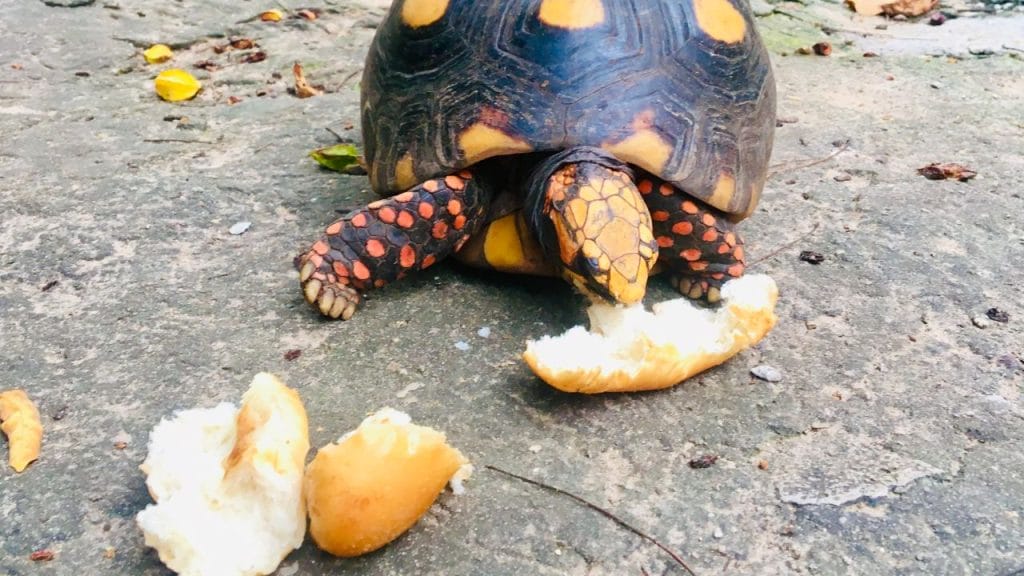
Tortoise Not Eating: Why?
It is not uncommon for pet tortoises to refuse food once in a while. But is that normal? In most cases, no.
Experts suggest that there may be an underlying issue behind this tortoise behaviour. For example,
A Drop In Temperature
Tortoises are cold-blooded species like turtles. Hence, they also require a warm environment to carry out their daily activities. Any drop in the temperature messes up their metabolism and lifestyle.
A cold environment seems to slow down the tortoise’s metabolism. Consequently, a drop in the heart rate, oxygen consumption and energy spending is exhibited.
Tortoises enter into a sleep-like state and barely eat or drink to keep their energy usage minimum. These creatures can live off the stored energy and in that hibernating state for months.
Thus, if your tortoise is refusing food, recheck the habitat temperature. Generally, the warm side of the enclosure should be around 95 – 100°F, and the cooler side should be about 75 – 85°F.
Feeling Sick
Sickness is another reason why tortoises resent food. When ill, these pets become lethargic and perform no daily activity at all. Instead, they channel the remaining energy to heal the wounds.
Refusing food and weight loss are common signs of any disease in tortoises. Therefore, look for any symptoms of illness in the tortoise and take action accordingly.
A regular medical checkup can spare you from this hassle and keep your pet tortoise healthy.
Learn about the signs and treatments of any tortoise disease from this article.
Stress Is Real
The mental health of tortoises is equally important as their physical health. Stress or anxiety of any kind can make these creatures act abnormally. Consequently, they refuse to eat at all.
Catching up in an accident, falling victim to a disease, rough handling, congested habitat, wrong food choice, etc., can stress a tortoise. Also, disturbing them and switching them to a new home can cause anxiety.
It is wiser to leave your tortoise alone if it is stressed. Besides, ensure proper care for the pet and avoid rough handling.
Boring Meals
Who loves the same meal again and again? No one and not even tortoises. If you keep feeding the pets the same veggies and plants every day, they will get bored and avoid eating.
So, experiment with different items to find out your tortoise’s taste. Bring variety by switching plants and vegetables from the list. It will make the meals interesting and appetizing for the tortoises.
How Long Can Tortoise Go Without Food And Water?
Tortoises can survive about a week without water and about 3 months without food. However, some sources claim that tortoises can survive more than 3 years without food.
Water is essential for all tortoise species, even for the desert ones. Yes, they have less access to fresh drinking water, but their meals of cactus pads and plants contain water.
On average, a healthy tortoise lives 7 days without a drop of water in a low humid area. The young and weak ones may not survive more than a few days. Going without water raises the complexion of tortoises and does severe health damage.
When it comes to food, tortoises can live for months. But yes, they must have access to clean water. While hibernating, tortoises survive more than 3 months without eating.
According to some reports, tortoises can survive years without food. Is that true? Well, scientists are still working to discover and link the facts.
Conclusion
Tortoises are mainly herbivorous. Everything from weed, and plant stems to vegetables, these creatures eat them all. Of course, the sources should be safe and nontoxic.
However, some tortoises eat animal protein like worms, insects, dead animals, etc. Tortoises also enjoy fruits as occasional treats.
Considering the size, tortoises need more food and nutrition to function. For adults, a 5-day feeding schedule is perfect. When deciding on the meal chart, add 80 -90 % greens and fill the remaining with fruits or a commercial diet.
Your tortoise can’t benefit from perfect nutrition without:
- UVB lighting for calcium absorption → UVB Guide
- Proper heating for digestion → Heating Guide
- Feeding dishes to prevent impaction → Dish Guide
- Calcium supplements (specific products) → Supplement Guide
Complete equipment checklist: Tortoise Owner Essentials

About Author
Muntaseer Rahman started keeping pet turtles back in 2013. He also owns the largest Turtle & Tortoise Facebook community in Bangladesh. These days he is mostly active on Facebook.


